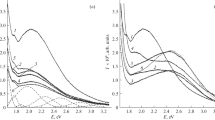Abstract
Congruently grown LiNbO3 single crystals show both high oxygen and lithium ion conductivity at temperatures above 500 °C. The high oxygen ion conductivity can be understood in terms of a certain amount of oxygen vacancies already present in congruently grown LiNbO3 single crystals. Thermal treatment of LiNbO3 produces additional oxygen vacancies. The absorption bands introduced by this procedure are investigated. It is found that the electrons which are generated during the reduction process are homogeneously distributed among all oxygen vacancies in the LiNbO3 single crystals. The electrocoloration phenomenon in LiNbO3 single crystals is due to the process of injection of lithium ions and electrons into LiNbO3 by a double charge mechanism. Investigations of the optical and electrical properties of electrocolored LiNbO3 crystals are reported. It is shown that the absorption spectra of thermally and electrochemically reduced samples are identical and that the origin of the absorption processes has to be therefore the same in both cases. That means, additional electrons produced by the double charge injection of lithium ions and electrons are also homogeneously distributed among the oxygen vacancies. This supports our hypothesis that a certain amount of oxygen vacancies has to be present already in as-grown LiNbO3 single crystals.
Similar content being viewed by others
6. Reference
R.J. Holmes and D.M. Myth, J. Appl. Phys.55, 3531 (1984).
A. Rauber in:Current Topics in Materials Science (North-Hollamd, New York, 1978) vol. 1, Chapt. 1, p.481.
O.F. Schirmer, O. Thiemann and M. Wohlecke, J. Phys. Chem. Solids52, 185 (1981).
H. Fay, W.J. Alford and H.M. Dess, Appl.Phys. Lett.12, 89 (1968).
P. Lerner, C. Legras and J.P. Dumas, J. Cryst. Growth3/4, 231 (1968).
K. Nassau and M.E. Lines, J. Appl. Phys.41, 533 (1970).
S.C. Abrahams and P. Marsh, Acta crystallogr.B42, 61 (1986).
R. Pareja, R. Gonzalez and M.A. Pedrosa, Phys. Stat. Sol. (a)84, 179 (1984).
R. Hodgson and F. Agullo-Lopez, Solid State Communications64, 965 (1987).
B.S. Red'kin, V.N. Kurlov and V.A. Tatarchenko, J. of Crystal Growth82, 106 (1987).
B. Red'kin, Ferroelectrics158, 145 (1994).
P.J. Jorgensen and R.W. Bartlett, J. Phys. Chem. Solids30, 2639 (1969).
T. Ishihara, H. Matsuda, Y. Takita, Solid State Ionics86–88, 197 (1996).
S. Bredikhin, T. Hattori and M. Ishigame, Solid State Ionics67, 311 (1994).
Author information
Authors and Affiliations
Corresponding author
Rights and permissions
About this article
Cite this article
Bredikhin, S., Scharner, S., Klingler, M. et al. Change of the stoichiometry and electrocoloration due to the injection of Li and O ions into lithium niobate crystals. Ionics 3, 470–476 (1997). https://doi.org/10.1007/BF02375728
Received:
Accepted:
Issue Date:
DOI: https://doi.org/10.1007/BF02375728




